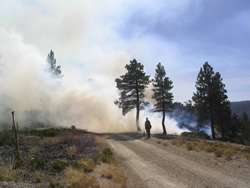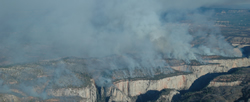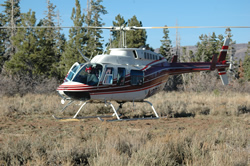
National Fire Plan Success Story
Three Finger Mesa Prescribed Fire Successfully Completed
Zion National Park, Utah
National Fire Plan - Fuels Reduction
2009

Blacklining along park boundary road.

Full ignition had to wait until the clearing index improved allowing for better smoke dispersal.

A Type III helicopter was used for aerial ignition.
After many years of planning and cooperation between interagency partners and private landowners, the Three Finger Mesa Prescribed Fire (Rx) was successfully completed during the last week of October 2008. The 2,100 acre prescribed fire project was located along the northern portion of the park boundary, southeast of Lava Point. The unit had been previously identified as one of the original wildland-urban interface “Focus Areas” located in the Color Country Interagency Fire Management Area that required some type of immediate fuel reduction treatment to protect communities/properties from the threat of wildland fire. The park worked closely with the Bureau of Land Management and the Latter Day Saints (LDS) Church, both of whom own land adjacent to the park and within the burn unit, as well as local residents of the Kolob area who coordinated with the park in the completion of a Community Fire Plan.
Management goals of the burn were to maintain boundary protection by reducing excess hazardous fuels and to apply fire to the landscape, thus maintaining the natural role it plays in the ponderosa pine ecosystem. One of the specific goals of this burn was to protect a LDS Church Camp adjacent to the park boundary. This camp hosts hundreds of young people throughout the summer and is limited to a single access road that could be compromised if a wildfire occurred. The prescribed fire helped to reduce the threat that fire poses to the camp and access road and provide firefighters a safer area in which to manage the park boundary and adjoining private property.
The first phase of the project was a long-term mechanical reduction of excess fuel along the northern and eastern boundaries of the burn unit. Once the fuel reduction was completed, hand ignition was used to begin the black lining operation along a private road, which borders a section of the northern boundary of the park. This phase of the operation created a buffer zone that helped to ensure the fire stayed within the predetermined burn unit. Due to a poor clearing index (a measure of air stability that correlates to smoke dispersion), after the black lining operation was completed, firefighters were not able to immediately start ignition of the interior of the burn unit. These unfavorable weather conditions made for smoky conditions in the Zion Canyon area for a number of days, especially in the late evening and early morning hours.
Once the clearing index improved to acceptable levels, hand and aerial ignition of the interior of the unit began, and were completed in one day. Favorable weather conditions made for good ventilation and allowed the smoke from the burn to dissipate rather that settle into the canyons at night. Park personnel closely monitored the fire until it was declared out after receiving precipitation.
The successful completion of the Three Finger Mesa Prescribed Fire is a good example of how interagency partners and private landowners can work together to accomplish management goals to benefit all. The private lands will benefit from the burn by reducing their risks from wildfire and the park and interagency partners benefit from the restoration of fire to the ecosystem. The policy of using fire as a tool will decrease risks to life, property, and resources, and will help perpetuate the natural values for which Zion National Park was established.
Contact: David Eaker, Fire Communication and Education Specialist, (435) 772-7811.